unit2教案
- 格式:doc
- 大小:94.50 KB
- 文档页数:6
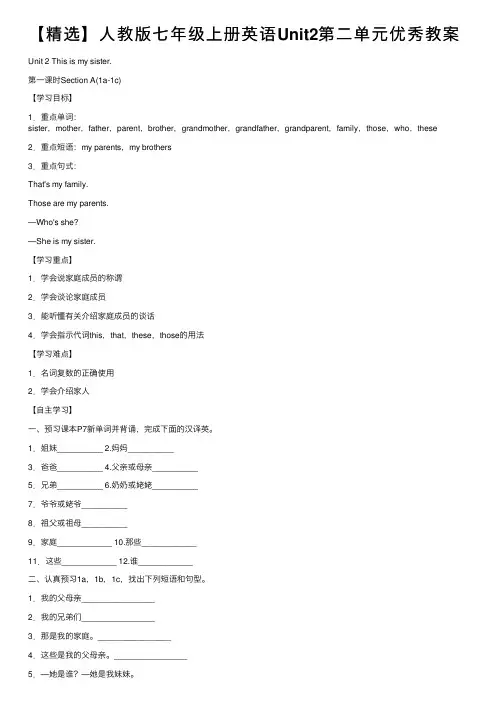
【精选】⼈教版七年级上册英语Unit2第⼆单元优秀教案Unit 2 This is my sister.第⼀课时Section A(1a-1c)【学习⽬标】1.重点单词:sister,mother,father,parent,brother,grandmother,grandfather,grandparent,family,those,who,these 2.重点短语:my parents,my brothers3.重点句式:That's my family.Those are my parents.—Who's she?—She is my sister.【学习重点】1.学会说家庭成员的称谓2.学会谈论家庭成员3.能听懂有关介绍家庭成员的谈话4.学会指⽰代词this,that,these,those的⽤法【学习难点】1.名词复数的正确使⽤2.学会介绍家⼈【⾃主学习】⼀、预习课本P7新单词并背诵,完成下⾯的汉译英。
1.姐妹__________ 2.妈妈__________3.爸爸__________ 4.⽗亲或母亲__________5.兄弟__________ 6.奶奶或姥姥__________7.爷爷或姥爷__________8.祖⽗或祖母__________9.家庭____________ 10.那些____________11.这些____________ 12.谁____________⼆、认真预习1a,1b,1c,找出下列短语和句型。
1.我的⽗母亲________________2.我的兄弟们________________3.那是我的家庭。
________________4.这些是我的⽗母亲。
________________5.—她是谁?—她是我妹妹。
_________________________________________________________________ 【课堂导学】Step 1情景导⼊Teacher:This is my family photo,and these are my family members.This is my father,and that is my mother.These are my grandparents.Can you introduce your family members to us?If you can't,don't worry.We will learn it this lesson.环节说明:由家庭照⽚引出本节课的重点——介绍家庭成员,激起了学⽣的学习兴趣,新课导⼊简单明了,过渡⾃然。

人教PEP版六年级英语上册第二单元教案Unit2Ways to go to school教学设计二、呈现(Presentatio n)1.main scene学习(1)呈现图片,仔细观察图片,回答问题,Where are they?What can you see?(2)学生仔细观察图片,展开合理想象并回答老师的问题。
Where are they?What can you see?(3)听录音,模仿朗读,理解对话内容。
①指明朗读对话,并翻译主要句子的中文意思,掌握单词、句子的读法。
2教师领读对话,学生模仿,齐读,生生对话,小组表演。
3告诉学生应该遵守交通规则,红灯停,绿灯行。
2.学习Let’s try&Let’s talk(1)T:Today I come to school on bus.Iusually come to school on foot.Whatabout you?Do you come by bike or bybus?Do you come on foot or by car?(2)Listen to the tape(3)快速反应游戏:教师说出某个短语,让学生做相应的动作并说出句子(4)听录音,跟读Let’s talk内容,注意纠正学生的发音(5)图片解释usually/often/sometimes单词的区别。
(100%80%60%40%0)(6)同桌表演对话,培养学生学习语言,课堂上激发学生不断地去说,再引入课文内容的学习。
1、free talk形式,先跟学生展开对话,让学生在学习新内容前先巩固已学过的知识。
2、通过听、游戏、动作去了解短文意思,并通过学习,引出频率副词的学习,让学生自然而然地掌握,了解所发生频率不一样,需要用不同的频率副词。
三、操练(Practice )1.Listen to the tape.Listen to the tape and read after it.2.Play a chain game教师做动作,自问自答:How doI come to school?I come to school by bike,继续重复刚才的句子并问某一位学生,继续传递下去。
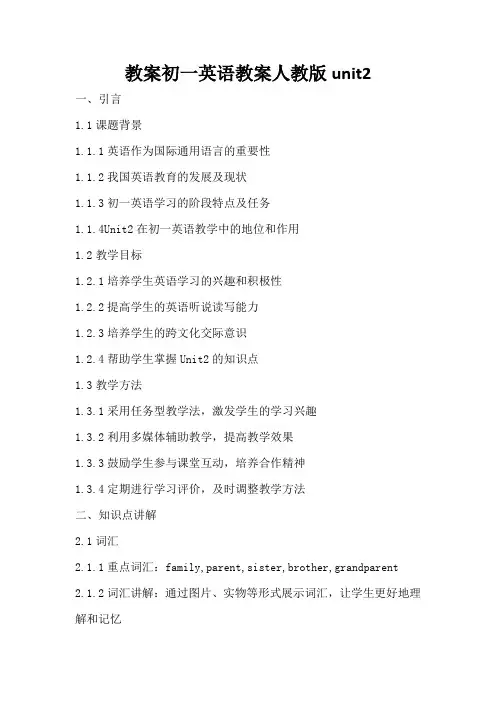
教案初一英语教案人教版unit2一、引言1.1课题背景1.1.1英语作为国际通用语言的重要性1.1.2我国英语教育的发展及现状1.1.3初一英语学习的阶段特点及任务1.1.4Unit2在初一英语教学中的地位和作用1.2教学目标1.2.1培养学生英语学习的兴趣和积极性1.2.2提高学生的英语听说读写能力1.2.3培养学生的跨文化交际意识1.2.4帮助学生掌握Unit2的知识点1.3教学方法1.3.1采用任务型教学法,激发学生的学习兴趣1.3.2利用多媒体辅助教学,提高教学效果1.3.3鼓励学生参与课堂互动,培养合作精神1.3.4定期进行学习评价,及时调整教学方法二、知识点讲解2.1词汇2.1.1重点词汇:family,parent,sister,brother,grandparent 2.1.2词汇讲解:通过图片、实物等形式展示词汇,让学生更好地理解和记忆2.1.3词汇练习:设计丰富的练习,如填空、选择、匹配等,巩固学生对词汇的掌握2.1.4词汇运用:鼓励学生在实际情景中运用所学词汇,提高语言运用能力2.2语法2.2.1重点语法:一般现在时2.2.2语法讲解:通过例句、图表等形式讲解一般现在时的构成和用法2.2.3语法练习:设计针对性的练习,如填空、改错、句型转换等,让学生熟练掌握一般现在时2.2.4语法运用:鼓励学生在写作、口语表达中运用一般现在时,提高语法运用能力2.3对话2.3.1重点对话:介绍家庭成员2.3.2对话讲解:分析对话内容、功能及语言特点2.3.3对话练习:设计角色扮演、问答等练习,让学生熟悉并运用对话2.3.4对话拓展:鼓励学生结合自身实际,创作类似的对话,提高交际能力三、教学内容3.1课文3.1.1课文内容:Unit2的课文主要围绕家庭成员展开3.1.2课文讲解:分析课文结构、语言点及文化背景3.1.3课文练习:设计阅读理解、完型填空等练习,提高学生的阅读能力3.1.4课文拓展:引导学生探讨课文主题,培养学生的思辨能力和跨文化意识3.2听力3.2.1听力材料:与家庭成员相关的对话、短文等3.2.2听力讲解:教授听力技巧,如预测、捕捉关键信息等3.2.3听力练习:设计听辨、听写、听力理解等练习,提高学生的听力水平3.3语音3.3.1重点语音:元音音素/i:/和/i/3.3.2语音讲解:讲解元音音素的发音特点及区别3.3.3语音练习:设计听音辨词、模仿朗读等练习,让学生掌握元音音素的发音3.3.4语音拓展:引导学生关注日常生活中的语音现象,提高语音感知能力四、教学目标4.1知识与技能4.1.1掌握Unit2的重点词汇、语法和对话4.1.2能够运用Unit2的知识进行简单的英语交际4.1.3提高英语听说读写能力4.1.4培养跨文化交际意识4.2过程与方法4.2.1培养学生合作学习的能力4.2.2培养学生自主学习的能力4.2.3培养学生解决问题的能力4.2.4培养学生创新思维的能力4.3情感态度与价值观4.3.1培养学生对英语学习的兴趣和积极性4.3.2培养学生尊重和包容不同文化的态度4.3.3培养学生团队合作的精神4.3.4培养学生积极向上的价值观五、教学难点与重点5.1教学难点5.1.1词汇的掌握和运用5.1.2一般现在时的语法运用5.六、教具与学具准备6.1教师准备6.1.1多媒体课件:包括词汇、语法、对话的展示和练习6.1.2图片和实物:用于展示家庭成员,增强视觉效果6.1.3录音设备:播放听力材料,进行听力练习6.1.4教学视频:用于辅助教学,提供更多的语言输入6.2学生准备6.2.1英语课本和练习册:学习Unit2的相关内容6.2.2笔记本和文具:记录重点知识和练习答案6.2.3家庭照片:用于介绍家庭成员的实践活动6.2.4英语词典:查找生词,自主学习6.3课堂环境6.3.1座位安排:适合小组活动和角色扮演6.3.2黑板和白板:用于板书和展示学生答案6.3.3墙面海报:展示英语学习标语和家庭成员词汇七、教学过程7.1导入7.1.1开场白:用英语与学生打招呼,引入新课话题7.1.2快速问答:复习上一课的内容,激活学生的相关知识7.1.3图片展示:展示家庭成员的图片,引起学生的兴趣7.1.4目标介绍:告知学生本节课的学习目标和预期成果7.2主体教学7.2.1词汇学习:通过图片和实物学习重点词汇7.2.2语法讲解:通过例句和图表讲解一般现在时7.2.3对话练习:分组练习对话,模拟真实场景7.2.4听力训练:播放听力材料,进行听力和理解练习7.3巩固与拓展7.3.1小组活动:设计家庭成员介绍的小游戏或角色扮演7.3.2课堂写作:写一段关于自己家庭成员的短文7.3.3语音练习:模仿录音,练习元音音素的发音7.3.4作业布置:布置课后作业,巩固所学知识八、板书设计8.1词汇板书8.1.1重点词汇列表:在黑板上列出Unit2的重点词汇8.1.2词汇例句:用不同颜色的粉笔标出词汇在例句中的使用8.1.3词汇配图:在词汇旁边画上简笔画,增强记忆8.1.4词汇游戏:设计一个与词汇相关的游戏,如“找不同”8.2语法板书8.2.1语法规则:用图表形式展示一般现在时的构成8.2.2语法例句:用例句展示一般现在时的用法8.2.3语法练习:在黑板上展示语法练习题,让学生参与解答8.3对话板书8.3.1对话脚本:在黑板上写出对话的脚本,供学生参考8.3.2对话角色:标明对话中不同角色的名称8.3.3对话情景:用图画或关键词表示对话发生的情景8.3.4对话提示:给出表演对话时的表情和动作提示九、作业设计9.1词汇作业9.1.1词汇填空:完成练习册上的词汇填空题9.1.2词汇匹配:将词汇与图片或定义进行匹配9.1.3词汇造句:用Unit2的词汇各造一个句子9.1.4词汇复习:复习Unit2的所有词汇,准备下次课的测试9.2语法作业9.2.1语法改错:改正练习册上的语法错误9.2.2语法填空:完成一般现在时的语法填空题9.2.3语法转换:将句子从一般现在时转换为其他时态9.2.4语法写作:用一般现在时写一段短文9.3对话作业9.3.1对话背诵:背诵Unit2的对话9.3.2对话改编:改编Unit2的对话,加入自己的家庭成员9.3.3对话表演:与同学一起表演Unit2的对话9.3.4对话创作:创作一个新的对话,介绍自己的家庭成员十、课后反思及拓展延伸10.1教学效果反思10.1.1学生参与度:重点和难点解析一、知识点讲解中的词汇部分1.1词汇的讲解与练习详细讲解每个重点词汇的用法和搭配,确保学生理解并能够正确使用。
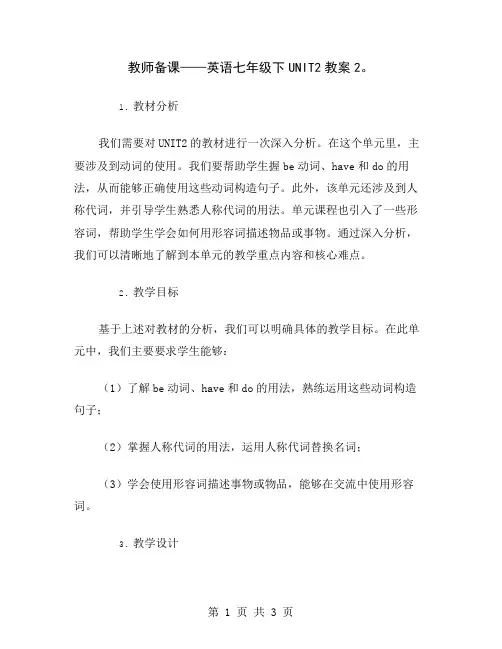
教师备课——英语七年级下UNIT2教案2。
1.教材分析我们需要对UNIT2的教材进行一次深入分析。
在这个单元里,主要涉及到动词的使用。
我们要帮助学生握be动词、have和do的用法,从而能够正确使用这些动词构造句子。
此外,该单元还涉及到人称代词,并引导学生熟悉人称代词的用法。
单元课程也引入了一些形容词,帮助学生学会如何用形容词描述物品或事物。
通过深入分析,我们可以清晰地了解到本单元的教学重点内容和核心难点。
2.教学目标基于上述对教材的分析,我们可以明确具体的教学目标。
在此单元中,我们主要要求学生能够:(1)了解be动词、have和do的用法,熟练运用这些动词构造句子;(2)掌握人称代词的用法,运用人称代词替换名词;(3)学会使用形容词描述事物或物品,能够在交流中使用形容词。
3.教学设计基于教材分析和教学目标,我们需要进行详细的教学设计。
我们可以通过提供一些生动的语言材料,向学生展示be动词、have和do 的用法。
在这个过程中,可以帮助学生发现一些常见的语言规律和用法,如肯定句、否定句和疑问句等。
同时,也可以通过练习帮助学生熟悉这些动词的使用方法。
我们可以引导学生熟悉人称代词的使用。
通过对语言材料的分析和练习,学生可以逐渐理解代词在句子中的作用和用法,并掌握有效地使用人称代词进行交际的技能。
我们可以引入形容词,让学生重点了解形容词与名词搭配方法,并且在生活实践中加强彼此搭配的印象。
在此过程中,教师要注意语言的生动性和趣味性,让学生更好地理解用法,同时,鼓励他们在交流中积极运用词汇。
4.教学评估在教学过程中,我们需要对学生的掌握情况进行评估。
在这个过程中,我们可以使用各种形式的评估方法,如听力、口语、阅读和写作等,以帮助学生全面地巩固并使用教材中的词汇和语法。
5.课后回顾最后要注意的是,教师在教学结束后,应该对教学过程进行总结和回顾,以保证学生可以更好地理解和掌握所学的内容。
在回顾过程中,可以和学生讨论一些重点难点,从而加深对其的印象,巩固所学的知识。
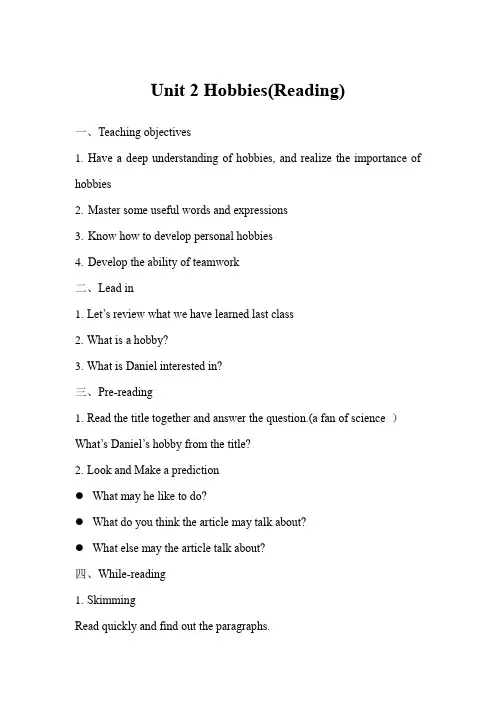
Unit 2 Hobbies(Reading)一、Teaching objectives1.Have a deep understanding of hobbies, and realize the importance of hobbies2.Master some useful words and expressions3.Know how to develop personal hobbies4.Develop the ability of teamwork二、Lead in1.Let’s review what we have learned last class2.What is a hobby?3.What is Daniel interested in?三、Pre-reading1.Read the title together and answer the question.(a fan of science )What’s Daniel’s hobby from the title?2.Look and Make a prediction●What may he like to do?●What do you think the article may talk about?●What else may the article talk about?四、While-reading1.SkimmingRead quickly and find out the paragraphs.2.Careful reading(1)Find more details in different parts(2)Can you find out words to show time and places? Circle some words. (often, at home, in his free time, at school)(3)Further thinking●Imagine if you are Daniel, what may do you do at school?●What is hobby?(Discussion)(4)Finish Part B●Find out the answers of part B●Discussion:⏹Which words can show Daniel’s love for science?⏹Daniel thinks science is all around us and changes our lives.Doyou agree?⏹What does Daniel get from his hobby?⏹What can we get from a good hobby?(5)Discuss Daniel’s dreamHe wants to be a scientist one day.I am sure his dream come true.(6)Finish Part C●Choose some words and finish Part C●Discuss the function of “wow, so cool”. It can shows support in aconversation.●Discussion:⏹Why are they so sure that Daniel will become a scientist?⏹What makes a scientist?(good qualities, much knowledge, much practice, and endless questions)五、Post-reading1.Finish the chart and share your hobby2.Further thinking●Why are hobbies important to us?●What will life be like without hobbies?六、Homework1.Finish the exercise2.Recite the passage。
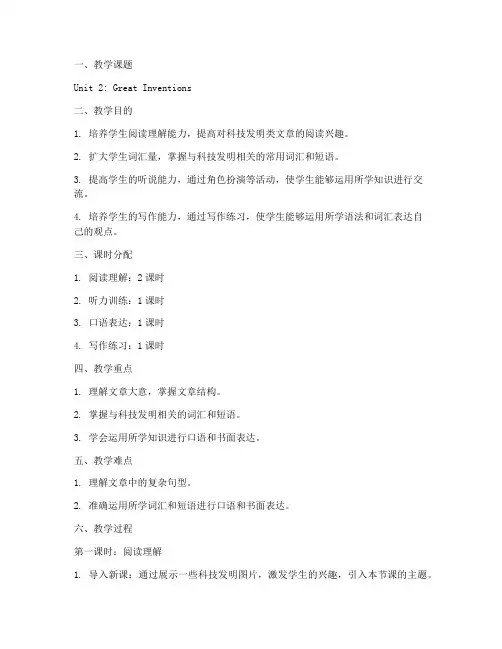
一、教学课题Unit 2: Great Inventions二、教学目的1. 培养学生阅读理解能力,提高对科技发明类文章的阅读兴趣。
2. 扩大学生词汇量,掌握与科技发明相关的常用词汇和短语。
3. 提高学生的听说能力,通过角色扮演等活动,使学生能够运用所学知识进行交流。
4. 培养学生的写作能力,通过写作练习,使学生能够运用所学语法和词汇表达自己的观点。
三、课时分配1. 阅读理解:2课时2. 听力训练:1课时3. 口语表达:1课时4. 写作练习:1课时四、教学重点1. 理解文章大意,掌握文章结构。
2. 掌握与科技发明相关的词汇和短语。
3. 学会运用所学知识进行口语和书面表达。
五、教学难点1. 理解文章中的复杂句型。
2. 准确运用所学词汇和短语进行口语和书面表达。
六、教学过程第一课时:阅读理解1. 导入新课:通过展示一些科技发明图片,激发学生的兴趣,引入本节课的主题。
2. 阅读课文:学生自主阅读课文,了解文章大意,掌握文章结构。
3. 翻译练习:学生翻译文章中的重点句子,巩固词汇和语法知识。
4. 课堂讨论:针对文章中的关键问题进行讨论,加深对文章内容的理解。
第二课时:听力训练1. 导入新课:通过播放一段与科技发明相关的英语听力材料,激发学生的兴趣。
2. 听力练习:学生听录音,回答问题,提高听力理解能力。
3. 课堂讨论:针对听力材料中的关键问题进行讨论,加深对内容的理解。
第三课时:口语表达1. 导入新课:通过展示一些科技发明图片,激发学生的兴趣,引入本节课的主题。
2. 角色扮演:学生分组进行角色扮演,模拟科技发明场景,运用所学知识进行交流。
3. 课堂讨论:针对角色扮演中的问题进行讨论,提高口语表达能力。
第四课时:写作练习1. 导入新课:通过展示一些科技发明案例,激发学生的写作兴趣。
2. 写作指导:教师讲解写作技巧,指导学生如何运用所学知识进行写作。
3. 写作练习:学生根据所学知识,撰写一篇关于科技发明的短文。
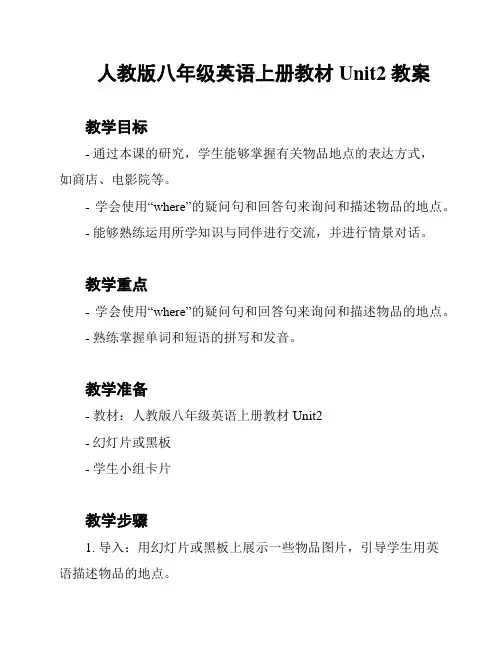
人教版八年级英语上册教材Unit2 教案
教学目标
- 通过本课的研究,学生能够掌握有关物品地点的表达方式,
如商店、电影院等。
- 学会使用“where”的疑问句和回答句来询问和描述物品的地点。
- 能够熟练运用所学知识与同伴进行交流,并进行情景对话。
教学重点
- 学会使用“where”的疑问句和回答句来询问和描述物品的地点。
- 熟练掌握单词和短语的拼写和发音。
教学准备
- 教材:人教版八年级英语上册教材Unit2
- 幻灯片或黑板
- 学生小组卡片
教学步骤
1. 导入:用幻灯片或黑板上展示一些物品图片,引导学生用英
语描述物品的地点。
2. 研究新知:通过教材Unit2的相关内容,教授目标词汇和短语,让学生理解并记忆。
3. 练活动:进行对话练,学生分组,每个小组选择一个物品进行情景对话,询问和回答物品的地点。
4. 拓展活动:让学生运用所学知识,创造自己的对话,交流物品的地点。
5. 归纳总结:让学生回顾所学知识,进行总结归纳。
6. 作业布置:布置课后作业,要求学生练复述本课内容,并使用疑问句和回答句描述物品地点。
教学评价
- 通过学生的课堂表现、练活动和讨论活动来进行评价,检查学生是否能够正确运用所学语言进行物品地点的描述。
- 提供及时的反馈,鼓励学生用英语进行交流。
注意事项
- 确保课堂秩序,引导学生积极参与。
- 注重学生的口语能力培养,鼓励他们进行对话练。
- 提供足够的练机会,让学生熟练掌握所学知识。
以上为人教版八年级英语上册教材Unit2的教案,根据课堂实际情况适当调整教学步骤。
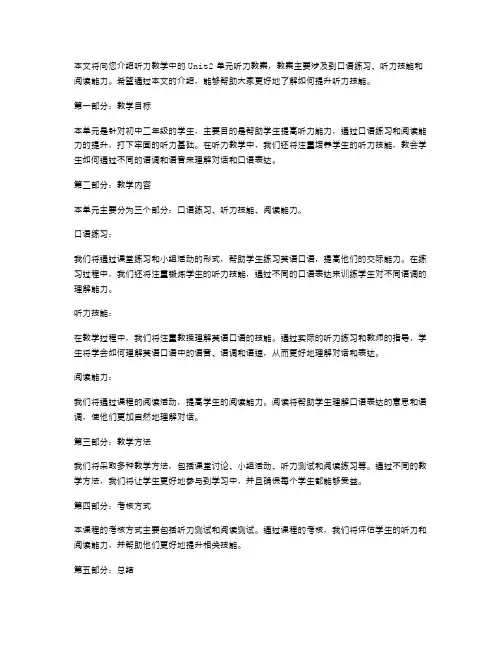
本文将向您介绍听力教学中的Unit2单元听力教案,教案主要涉及到口语练习、听力技能和阅读能力。
希望通过本文的介绍,能够帮助大家更好地了解如何提升听力技能。
第一部分:教学目标本单元是针对初中二年级的学生,主要目的是帮助学生提高听力能力,通过口语练习和阅读能力的提升,打下牢固的听力基础。
在听力教学中,我们还将注重培养学生的听力技能,教会学生如何通过不同的语调和语音来理解对话和口语表达。
第二部分:教学内容本单元主要分为三个部分:口语练习、听力技能、阅读能力。
口语练习:我们将通过课堂练习和小组活动的形式,帮助学生练习英语口语,提高他们的交际能力。
在练习过程中,我们还将注重锻炼学生的听力技能,通过不同的口语表达来训练学生对不同语调的理解能力。
听力技能:在教学过程中,我们将注重教授理解英语口语的技能。
通过实际的听力练习和教师的指导,学生将学会如何理解英语口语中的语音、语调和语速,从而更好地理解对话和表达。
阅读能力:我们将通过课程的阅读活动,提高学生的阅读能力。
阅读将帮助学生理解口语表达的意思和语调,使他们更加自然地理解对话。
第三部分:教学方法我们将采取多种教学方法,包括课堂讨论、小组活动、听力测试和阅读练习等。
通过不同的教学方法,我们将让学生更好地参与到学习中,并且确保每个学生都能够受益。
第四部分:考核方式本课程的考核方式主要包括听力测试和阅读测试。
通过课程的考核,我们将评估学生的听力和阅读能力,并帮助他们更好地提升相关技能。
第五部分:总结通过本单元的学习,学生将更好地理解英语口语,掌握英语语调和语音的技能。
同时,我们还将通过阅读能力的提升,帮助学生更好地理解口语表达的意思和语调。
因此,在接下来的学习中,学生将能够更好地应对英语口语的挑战,从而更加自信地参与到英语学习中去。
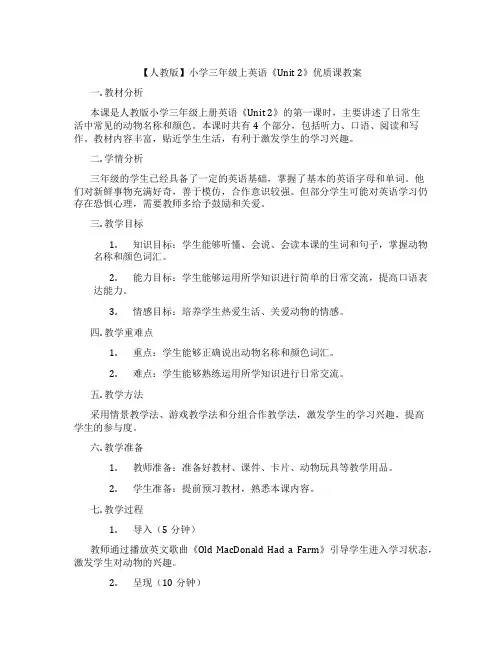
【人教版】小学三年级上英语《Unit 2》优质课教案一. 教材分析本课是人教版小学三年级上册英语《Unit 2》的第一课时,主要讲述了日常生活中常见的动物名称和颜色。
本课时共有4个部分,包括听力、口语、阅读和写作。
教材内容丰富,贴近学生生活,有利于激发学生的学习兴趣。
二. 学情分析三年级的学生已经具备了一定的英语基础,掌握了基本的英语字母和单词。
他们对新鲜事物充满好奇,善于模仿,合作意识较强。
但部分学生可能对英语学习仍存在恐惧心理,需要教师多给予鼓励和关爱。
三. 教学目标1.知识目标:学生能够听懂、会说、会读本课的生词和句子,掌握动物名称和颜色词汇。
2.能力目标:学生能够运用所学知识进行简单的日常交流,提高口语表达能力。
3.情感目标:培养学生热爱生活、关爱动物的情感。
四. 教学重难点1.重点:学生能够正确说出动物名称和颜色词汇。
2.难点:学生能够熟练运用所学知识进行日常交流。
五. 教学方法采用情景教学法、游戏教学法和分组合作教学法,激发学生的学习兴趣,提高学生的参与度。
六. 教学准备1.教师准备:准备好教材、课件、卡片、动物玩具等教学用品。
2.学生准备:提前预习教材,熟悉本课内容。
七. 教学过程1.导入(5分钟)教师通过播放英文歌曲《Old MacDonald Had a Farm》引导学生进入学习状态,激发学生对动物的兴趣。
2.呈现(10分钟)教师展示教材中的插图,引导学生说出图片中的动物和颜色。
教师出示卡片,让学生模仿发音,纠正发音错误。
3.操练(10分钟)教师学生进行小组活动,让学生互相提问动物和颜色,如:“What’s this? It’sa/an… What color is it?”学生用所学词汇进行回答。
4.巩固(5分钟)教师邀请学生上台展示自己的口语表达能力,其他学生进行评价。
教师给予鼓励和指导。
5.拓展(5分钟)教师引导学生发挥想象,用自己的语言描述一种喜欢的动物和颜色,学生互相分享。
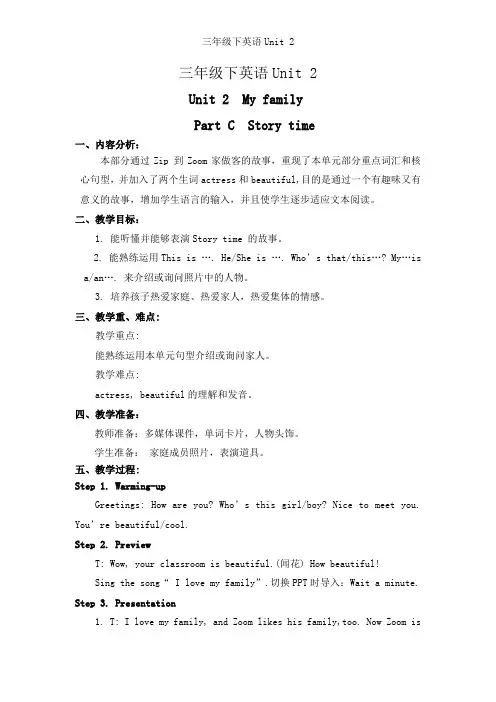
三年级下英语Unit 2Unit 2 My familyPart C Story time一、内容分析:本部分通过Zip 到Zoom家做客的故事,重现了本单元部分重点词汇和核心句型,并加入了两个生词actress和beautiful,目的是通过一个有趣味又有意义的故事,增加学生语言的输入,并且使学生逐步适应文本阅读。
二、教学目标:1. 能听懂并能够表演Story time 的故事。
2. 能熟练运用This is …. He/She is …. Who’s that/this…? My…is a/an…. 来介绍或询问照片中的人物。
3. 培养孩子热爱家庭、热爱家人,热爱集体的情感。
三、教学重、难点:教学重点:能熟练运用本单元句型介绍或询问家人。
教学难点:actress, beautiful的理解和发音。
四、教学准备:教师准备:多媒体课件,单词卡片,人物头饰。
学生准备:家庭成员照片,表演道具。
五、教学过程:Step 1. Warming-upGreetings: How are you? Who’s this girl/boy? Nice to meet you. You’re beautiful/cool.Step 2. PreviewT: Wow, your classroom is beautiful.(闻花) How beautiful!Sing the song“ I love my family”.切换PPT时导入:Wait a minute. Step 3. Presentation1. T: I love my family, and Zoom likes his family,too. Now Zoom istalking about his family with Zip. 切换PPT时重复:Wait a minute.带读。
2. T: Look at me! Look at the man. He’s….引导生说:He’s tall. T:Really? Yes, the man is tall. Look here,(指蝴蝶结) He’s cool.3. T: The man is cool. Here’s a woman. 教读“woman”.让生观看视频,回答:Who’s that woman?再次观看视频,选择:She’s tall/ cool/ beautiful.4. 指名学生读句子,T: You’re beautiful. 引导学生说:Thank you. 导入:The classroom is beautiful. The flowers are beautiful. PPT出示栀子花图,引导学生说:How beautiful!5. T: I’m a teacher. Is Zoom’s mother a teacher? 导入:She ’s an actress.出示明星图片,说明:They are actresses.6. T: Zoom’s mother is an actress. She has many beautiful clothes, maybe Zoom wants to wear the clothes, then what happened? T:Zoom likes his father and mother.They all like him. Zoom has a happy family. Step 4. Consolidation and extension1. 生自读故事;听录音跟读;分角色读;指名扮演。
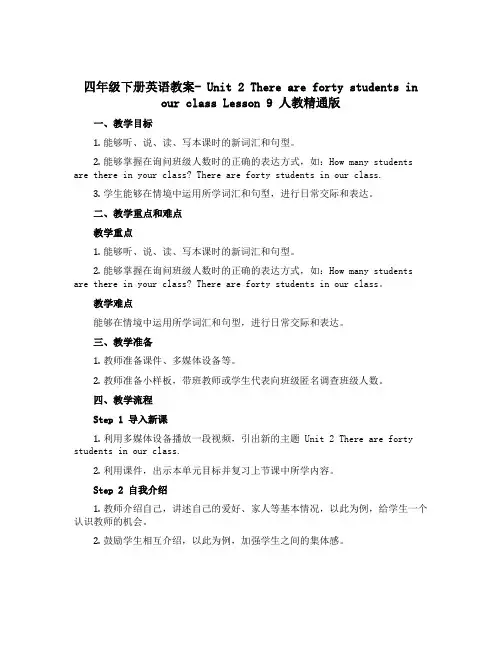
四年级下册英语教案- Unit 2 There are forty students inour class Lesson 9 人教精通版一、教学目标1.能够听、说、读、写本课时的新词汇和句型。
2.能够掌握在询问班级人数时的正确的表达方式,如:How many students are there in your class? There are forty students in our class.3.学生能够在情境中运用所学词汇和句型,进行日常交际和表达。
二、教学重点和难点教学重点1.能够听、说、读、写本课时的新词汇和句型。
2.能够掌握在询问班级人数时的正确的表达方式,如:How many students are there in your class? There are forty students in our class。
教学难点能够在情境中运用所学词汇和句型,进行日常交际和表达。
三、教学准备1.教师准备课件、多媒体设备等。
2.教师准备小样板,带班教师或学生代表向班级匿名调查班级人数。
四、教学流程Step 1 导入新课1.利用多媒体设备播放一段视频,引出新的主题 Unit 2 There are forty students in our class.2.利用课件,出示本单元目标并复习上节课中所学内容。
Step 2 自我介绍1.教师介绍自己,讲述自己的爱好、家人等基本情况,以此为例,给学生一个认识教师的机会。
2.鼓励学生相互介绍,以此为例,加强学生之间的集体感。
Step 3 学习新词汇和句型1.教师利用课件出示生词表,通过图片或单词解释等方式,学习本单元新词汇、短语。
2.教师出示对话,示范问询班级人数的正确表达方式。
3.请学生模仿示范,进行问询班级人数的情景对话练习。
Step 4 小组活动1.教师将学生分成若干个小组。
2.每个小组均需由一名代表或班主任向班级匿名调查班级人数,并记录在小样板上。
PEP 5B Unit 2 My favourite season一、教材结构分析教材截图(PEP )二、教材内容梳理三、单元教学内容要求分析四、学情分析辅音字母在单词中的发音为已知;特殊疑问词为略知;核心词汇和语篇为新知。
五、单元教学目标六、分课时教学目标七、分课时目标八、分课时教学设计教材内容A Let’s learn Let’s talk Let’s try Read and Match●主体学习文本:Mr Jones: Do you like the music, children?Mike: Yes. It’s very beautiful. What is it?Mr Jones: The Four Seasons. Today we’ll draw the seasons. Which season do you like best, Mike? Mike: Winter. I like snow.Mr Jones: I like snow, too. Which season do you like best, Wu Binbin?Mike: Spring. It’s pretty.Mr Jones: Yes, it is.●辅助文本:What’s your favourite colour?My favourite colour is…What’s the weather like in spring/ summer/ autumn/ winter?It’s warm and windy/ sunny and hot/ cool and rainy/ cold and snowy…预设输出语言:Which season do you like best?Summer./Spring./Autumn./Winter.It’s warm in spring. It’s cold and snowy in winter.…1.listen and recite the dialogue. Act it out in groups2.Finish the paper.课时任务单:【教学内容】教材内容B Let’s learn Let’s talk Ask and answer Let's spell●主体学习文本:Amy: Hello, Miss White. Look at my picture.Miss White: Good job! I like the trees. The colours are very pretty!Amy: Yes. I like autumn best. The weather is good and the colours are beautiful! Which season do you like best, Miss White?Miss White: Summer.Amy: Why?Miss White: Because I like summer vacation!●辅助文本:Which season do you like best?I like spring best.Why?Because I like…I can…There is/ are…●预设输出语言:Which season do you like best?I like spring best.Why?Because I like…I can…There is/ are…Br brother, brown…2. Some pictures about seasonsand characteristics.3.The setting:What’s your favourite season and what can you do?I can... Miss White and Amy are talking about the picture of season in art show.3猜谜游戏的形式展现并巩固与本节课相关的语音。
高一英语必修一unit2教案【5篇】高一英语必修一unit2教案【5篇】高一是同学适应高中英语学习的关键时期,作为一名高一英语老师,你知道如何写一篇英语教案?下面是我为你预备的高一英语必修一unit2教案,快来借鉴一下并自己写一篇与我们共享吧!高一英语必修一unit2教案精选篇5教学目标1. To practise listening comprehension.2.To practise making decisions and reasoning教学重难点1. To practise listening comprehension.2.To practise making decisions and reasoning教学工具课件教学过程Step1. revision1. check the homework exercises.1). It has been reported that children will be offered free education.It has been reported that free education will be offered to children.2). It has been said that we will be offered the latest computer science course book.It has been planned that the latest computer science course book will be offered to us.3). I have been told by Peter that I will be lent his notebook computer for a week.I have been told by Peter that his notebook computer will be lent to me for a week.2. Question: What can computers be used as?Step2. Lead-inAs we know, science and technology is developing very fast and computers have become smaller and smaller. They have been used in many fields. So, the 21st century is the century of information technology What does it mean? Does information technology/ IT only mean things like computers? Of cause not. Actually, it means more than computers. Computers are just one kind of IT. What else do you know is part of IT?(TV, radio, CD-ROM, DVD, books……)Step3. Listening (SB)1. Pre-listening: What are the changes brought by different forms of IT ?What are the advantages and disadvantages of them ?2. While-listening:Go through the chart and make sure the students look at the chart before they listen to the tape. (This is to sharpen their attention and listen for the answers. This will also help them get the gist of the text.) Then Listen to the tape and finish filling in the chart. (If necessary, play the tape for several times.)Say: After listening to their talk, we know all kinds of IT have both disadvantages and advantages.Let’s check the answers together.Type of IT Advantages DisadvantagesTV You can both listen and watch. You cannot write to friends.Web You can find information. It is very expensive.Radio You can listen to English. You cannot watch a film.Book You can get information. Sometimes it is out of date.3. Post-listening:1) (pair work): decide which type of IT is best for you to use right now. Make your choice and give your reasons by using the following expressions.I think that….In my opinion, ….I believe that….I agr ee because….I disagree because….I’ve decided that….2) (group work): Discussion :Computers are useful and have brought us lots of good things, but they also cause bad effects. What attitude should we have towards the computer? (Make good use of it but never get trapped by it.)Step4. Speaking1. Pre-speakingSay: From what we have learn, we should admit that computers and the web have a great influence on the school education as well as people’s life. It has come into people’s everyday life and many families hold computers in their homes. Now there is a task for you.2. While-speaking1) Situation: You have been asked by your parents to help choose computers for your home. You and your friend have looked at several computers. Talk about the special things each computer can do. Make a decision about which kind of computer to buy and explain why.Information input: Show students some pictures of different computers (desktop computer laptop computer …)Language input: Useful expressions (Repeat it to strengthen students’ ability of use it.)Supporting an opinion Challenging an opinionI think that … , because … Perhaps, but what if / about …First, … Have you thought about …One reason is that … What makes you think thatI think it is better because… I don’t like it because….(Pair work )Use the expressions to support your opinion or challenging other’s opinions.2) Oral report: (individual work )Do an oral report to your father and start your report like this: I looked at many different computers. The one I have chosen is the PEP personal computer. One of the main reasons is that it is suitable for homes. I found that…3. Post-speakingConclusion—What useful expression do we use to make a decision and reason?(In this way, they can review and use the words and phrases again.)Step6 Pre-writingSay: Imagine what problems and delights this android might have to deal with while it is serving you. Try yourself in someone else’s shoes is an important way of understanding how other people feel.Then discuss: You are an android. You work for a family with one child who is very spoiled. The parents want you to do everything for them. The parents are nice, but they often ask you to watch over their child. How do you feel? What would you do if the child asked you to do his/her homework for him/her? Would you ever tell the child “no”?Step7 WritingSay: Write a passage about the result of your discussion! It should contain:What do you have to do?What is the child like?What is the parents’ requirement of the child?What do the parents want you to do?What does the child want you to do?Then what will you do? How do you feel?Sample writing:Hello everybody, my name is Liu Yan.I am a 321 model android.I work for the Li family. Mr and Mrs Li work very hard too.Mr Li is an architect and designs great tall apartment blocks.Mrs Li is a doctor and has to look after many patients.I remember all the plans for Mr Lis projects and can tell Mrs Li which drugs are the best to give any particular patient. And I also look after their library. I store all the books that they borrow from their school or friends in my brain.Of course my brain is as large as a mountain, so work like that is no trouble to me.I really eat books just like people eat food.The Lis have a child who is very spoiled. He needs me to remember all his school textbooks so that I can do his homework for him.He just gives me the information on the subject, what has to be done and the page numbers and I get on with it while he enjoys himself with his friends.Sometimes I dont think it is right to do his homework for him — its somewhat cheating. However, his parents are very concerned at the pressure of work in school these days.The child has too much homework to do. They like him to go to the key school but they also want him to be able to have hobbies, learn to swim and keep fit! Poor child!So they consider me the most important person in the family after themselves.I am always introduced to their friends and play with visiting children.I am the perfect family academic aid and, although I was not cheap to buy, Mr Li says I was worth every yuan!Step8 AssessmentGet the students to assess their writing ability according to the following the questions:1. Is your composition well developed?2. Are your ideas well organized to the point?3. Do you have a good choice of words and idioms in your writing?4. Do you get a good mastery of complex structures of language?5. What kind of mistakes have you made in your writing?Step9: HomeworkWrite about your discussion. You may begin like this:Hello, everyone. My name is __X. I’m 321 model android.I work for the Li family….课后小结学了这节课,你有什么收获?课后习题完成课后习题一、二。
Unit 2 This is my sister.一、单元教材分析本单元围绕―家庭成员‖这一主题展开听、说、读、写等多种教学活动。
教学核心是用英语介绍家人和朋友,通过本单元的学习学生应该掌握对家庭成员的称呼;通过谈论―家庭‖的话题,使学生学会并掌握―介绍人物、识别人物‖的基本句型,进一步体会一般疑问句的用法,学会运用指示代词介绍人物,学会运用人称代词询问人物。
如:This is my sister。
Is that your brother? These are my parents。
Are those your brothers? 以及Who开头的特殊疑问句,一般疑问及其简单回答;运用名词的复数形式。
能够用英语向朋友介绍自己的家人,从而让他们了解自己的家庭。
二、单元学情分析从教材编排上说本单元是就第一单元认识朋友之后,仍接着学习用英语认知人,而与学生最为熟悉的人就是家庭成员,由了解同学们的名字很自然过度到了解对家庭成员的名字,以及对家庭成员的称呼,对学生们来说比较容易接受。
以前学的your, his, her, my等形容词性物主代词,在本单元中扔是重点学习的任务;但在本单元要接触名词的复数形式,以及be动词的复数形式,且本单元生词较多,因此本单元的学习任务比较艰巨。
三、单元教学建议本单元的学习应通过对人物个性化的描述,识别照片、图片,多媒体展示、真实情景表演等学习策略来掌握家庭成员的表达;学会指示代词、人称代词及Who问句及简单回答。
为学生创设真实的学习情景,让学生以小组形式交流学习,并在课堂上循环训练。
通过介绍家人和了解朋友的家人,增进彼此的了解,建立友谊,从而更好地尊重对方,理解家人。
四、单元课时分配本单元可用4课时完成教学任务:Section A1 (1a-2d) 用1课时Section A2 (Grammar Focus-3c) 用1课时Section B1 (1a-2c) 用1课时Section B2 (3a-Self Check) 用1课时Section A1 (1a-2d)一、教学目标:1. 语言知识目标:1) 能掌握对家庭成员的称呼的词汇及指示代词:sister, father, mother, grandfather, grandmother, brother, parent (s), grandparent (s), who, they, this, that, these, those 2)能掌握以下句型:①—This/That is his sister.②—These/Those are his parents.③—Who's she? —She's my s ister.④—Is this/that your sister? —Yes, she is./No, she isn't.⑤—Are these/those your parents? —Yes, they are./No, they aren't.3) 掌握指示代词this, that, these, those及它们所构成的介绍他人的句型。
外研社英语必修三unit2教案教案标题:外研社英语必修三Unit 2教案教学目标:1. 通过本单元的学习,学生将能够掌握有关旅行和交通方式的词汇和表达方式。
2. 学生将能够运用所学知识描述旅行经历和计划,并能够与他人讨论旅行和交通方式。
3. 学生将能够通过听、说、读、写等综合技能进行英语交流。
教学重点:1. 掌握与旅行和交通方式相关的词汇和表达方式。
2. 运用所学知识进行旅行经历和计划的描述。
3. 学会与他人讨论旅行和交通方式。
教学难点:1. 运用所学知识进行旅行经历和计划的描述。
2. 学会与他人讨论旅行和交通方式。
教学准备:1. 教材:外研社英语必修三教材Unit 2的教学内容。
2. 多媒体设备:投影仪、电脑等。
3. 教具:单词卡片、图片、录音机等。
教学过程:Step 1:导入新课(5分钟)1. 利用图片或实物引导学生讨论旅行和交通方式,激发学生的学习兴趣。
2. 引导学生回忆并复习与旅行和交通方式相关的词汇和表达方式。
Step 2:新课讲解(15分钟)1. 通过多媒体展示单词和短语的图片,引导学生学习和掌握新词汇和表达方式。
2. 通过示范和练习,帮助学生理解和掌握新课的语法和用法。
Step 3:听说训练(20分钟)1. 播放录音,让学生跟读和模仿录音内容,提高学生的听力和口语能力。
2. 分组讨论旅行经历和计划,学生之间进行信息交流和对话练习。
Step 4:阅读训练(15分钟)1. 分发阅读材料,让学生阅读并理解文章内容。
2. 组织学生进行小组讨论,回答与文章相关的问题。
Step 5:写作训练(20分钟)1. 引导学生根据所学知识,写一篇关于自己旅行经历或计划的短文。
2. 学生互相交换短文,进行修改和改进。
Step 6:课堂总结(5分钟)1. 教师对本节课的重点内容进行总结和回顾。
2. 学生提问和解答疑惑。
Step 7:作业布置(5分钟)1. 布置相关的课后作业,巩固所学知识。
2. 鼓励学生自主学习和探究,提高英语学习的兴趣和能力。
Unit 2 I’ll help to clean up the city parks.Teaching aims1.Knowledge Objects1)Master new words and main sentences.2)Know how to use could, should.3)Know how to offer help.4)Practice listening.2.Ability Objects1)Be able to master new words and main sentences.2)Be able to know how to use could, should.3)Be able to offer help3.Emotion attitudes and valuesLet students be happy to help others through study.Teaching keys1) words and phrases:clean up, city, give out, volunteer, , used to,2) Learn how to offer help:I’d like to work outside.I’ll help clean the city park.You could give out food at a food bank.Teaching difficultTO learn how to offer helpTeaching methodListening and speaking in small groupsStep one: Warming upStep two: Talk about some picturesStep three: How could we help people. Look at the ways you could help people in the picture. Then make your list .Step four: Listening1bListen and number the ways the boy and girl could help others.Step five:Read the conversation and answer the questions.Step six :Listening2a and 2bA group of students are planning a City Park Clean-Up Day. Listen and check (√) the things they are going to do to tell people about it.Step seven :Listening2bStep eight :PairworkStep nine: Homework。
❖New Horizon College English❖New Horizon College EnglishUnit 1Section AI.Lead-in1.How do you understand the two following quotations?1)There is no friendship, no love, like that of the parent for the child.— Henry Ward Beecher2) While we try to teach our children all about life, our children teach us what lifeis all about.— Angela Schwindt 2.Survey: How close are you and your parents?To what extent are you close to your parents?3.Watch some videos and discuss the questions below:1)What happened to the father and the son?2)Is there any conflict or disagreement between you and your parents? Andwhat should we do to settle the conflict or disagreement?II.Text StructurePart I (para.1-3)The daughter is leaving home for independence and the mother feels glad on the one hand and expresses her concern / doubt on the other.Part 2 (Para.4-7)The daughter leaves a mess in her rooms and the mother straightens up the rooms.Part 3 (Para.8) After the mother finds a large envelope with all the memorable things the parents gave to the daughter, the mother’s attitude changes/reverses completely.III. Detailed Study1. Words in Using1)awaitvt. 1 wait for sth. 等待;等候e.g. The little boy was still awaiting his father’s return when the clock struck 11.当时钟敲响11 点时,那个小男孩仍在等着他爸爸回来。
2 if sth. awaits you, it will happen to you (某事)将降临到…身上e.g. The biggest surprise awaiting the birthday girl is that her father is flying toLondon for her birthday.那个过生日的女孩即将得到的最大惊喜是她爸爸将飞到伦敦来为她庆祝生日。
2)embarrassmentn. 1 [C] sb. or sth. that causes problems or makes you feel ashamed 让人难堪的人;使人为难的事e.g. He is such an embarrassment to his family. 他让他的家人感到非常难堪。
2 [U] a feeling of being nervous or ashamed because of what people know orthink about you 尴尬;难堪;窘迫e.g. To her terrible embarrassment, there were many people around when one ofher high heels broke off.她一只高跟鞋的鞋跟断了,当时周围有许多人,这让她很尴尬。
3)polishn. [C, U] a chemical substance that you rub onto an object to make it shine 上光剂;擦光剂e.g. The girl was told by her parents to remove the polish from her nails becauseshe was too young for make-up.女孩的父母让她把指甲油擦掉,因为她还太小,不适合化妆。
vt. 1 make sth. smooth, bright, and shiny by rubbing it 擦亮;擦光e.g. He polished his glasses with a handkerchief in order to see more clearly.他用手帕擦了擦眼镜,以便看得更清楚些。
2 improve a piece of writing, a speech, etc. by making slight changes to it beforeit is completely finished 修改;润色e.g. Your essay is good; you just need to polish it a bit.你的文章不错,你只要稍加润色就可以了。
4)comicn. [C] (also ~ book) a magazine for children that contains stories told in a seriesof drawings (儿童)连环漫画册e.g. With the combination of pictures and texts, comics are a good way to getchildren to begin their adventures in reading.连环漫画册图文并茂是让儿童开始接触阅读的一个好办法。
a. amusing you and making you want to laugh 滑稽的;好笑的e.g. Even the misfortune in his personal life was used by him in creating hiscomic movies.连他生活中的不幸遭遇也被他用于创作喜剧电影。
5) clumsya. 1 not easy to use and often large and heavy (物体)笨重的e.g. The first mobile phones were heavy and clumsy to use, but nowadays theyare much easier to handle.第一代手机用起来很笨重,不过如今的手机用起来方便多了。
2 moving in an awkward way and tending to make things fall over 笨拙的;不灵活的e.g. When people get drunk, they become clumsy and cannot speak clearly.人们喝醉后会变得行动笨拙,说话含糊。
6) curlv. form a twisted or curved shape, or make sth. do this 盘绕;缠绕e.g. It seems to me that the best way to relax is to curl up in the sofa with a cup oftea, and watch TV.对我而言,最好的放松方法就是泡上一杯茶,蜷在沙发上看电视。
7) strainvi. pull hard at sth. or push hard against sth. 使劲拉;使劲推;绷紧e.g. The dog strains at the rope fastened to its collar, eager to be off.那只狗使劲拽着拴在脖子上的绳子,拼命要挣脱。
vt. injure a muscle or part of your body by using it too much or making it work too hard 拉伤;扭伤;损伤e.g. I strained a muscle in my back when playing tennis.我在打网球时拉伤了背上的一块肌肉。
n.[C, U] worry that is caused by having to deal with a problem or work too hard over a long period of time 焦虑;紧张e.g. We know that a long time without change can lead to boredom, and physicaland mental strain.我们知道,长时间没有变化会导致乏味,以及身体和精神上的紧张。
8) curbn. [C] (BrE kerb) the raised edge of a road, between where people can walk and cars can drive 路缘e.g. For the sake of safety, please walk as close to the curb as possible. 为了安全起见,请尽量靠近路缘走路。
vt. control or limit sth. in order to prevent it from having a harmful effect 控制;抑制;约束e.g. The government should take steps to curb the rapid rise in housing prices.政府应采取措施抑制房价的快速上涨。
9) stripvt. (also ~ off)1 remove sth. that is covering the surface of sth. else 剥去;除去e.g. She asked us to strip off the sheets and bring them downstairs when we leave.她叫我们离开时把床单撤下来并带到楼下。